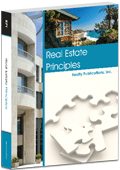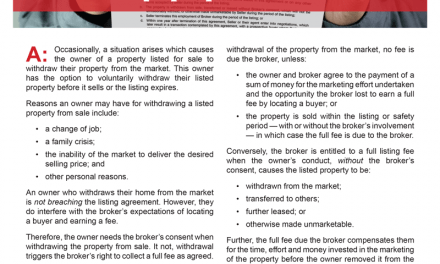A seller’s worst nightmare is receiving an appraisal value lower than the original purchase price. But what causes this horror? Is it obsolescence? Or maybe economic, social and government considerations?
One uncomfortable but inescapable factor is the neighborhood’s racial makeup. If real estate professionals are to thrive in California’s increasingly diverse market, they will need to learn how to spot remnants of the industry’s racist past.
An opinion of value
An appraisal is an opinion estimating a property’s value by analyzing facts about the property. The most common way to establish the fair market value (FMV) of residential real estate through appraisal is by applying the market comparison approach.
With the market comparison approach, also known as the sales comparison approach, the appraiser examines recent selling prices of nearby properties with similar characteristics to establish the property’s comparable value.
To deliver a fair and unbiased report, appraisers analyze property data on comparable properties (comps) and are required to apply uniform standards across the board on each property. Yet, the appraisal process still relies on a significant amount of subjectivity.
Appraisers determine the value of property characteristics by pulling from a range of prices, rather than one singular, easily defined price point. An aspect of the property, an attached garage, for example, may be calculated at a value between $10,000 and $20,000, but the appraiser is the one who determines whether that valuation will be in the upper or lower part of that range.
Despite all efforts to make appraisals fair, equitable and based on facts, racial appraisal gaps persist.
Related Video: Three Appraisal Approaches: Market Comparison
Click here for more information on this topic.
An observable gap
A recent report conducted by Freddie Mac found that appraisers’ opinions of value are more likely to fall below the purchase price originally paid for in majority Black and Latinx neighborhoods than in majority white neighborhoods. Further, the extent of the gap increases as the percentage of Black and Latinx people in the neighborhood increases.
The research is based on 12 million nationwide appraisals for sales transactions submitted to Freddie Mac between 2015 and 2020. Neighborhood demographics are established through 2010 Census data. When the share of Black or Latinx people in a neighborhood exceeds 50% of the population, the neighborhood is classified as Black or Latinx. When the share of Black or Latinx people in a neighborhood falls below 50%, the neighborhood is classified as white.
Properties in Black and Latinx neighborhoods receive appraisal values lower than the purchase price more often than properties in white neighborhoods. 12.5% of the properties in Black neighborhoods receive appraisal values lower than the purchase price compared to 7.4% in white neighborhoods.
Thus, a 5.2% appraisal gap emerges between white and minority neighborhoods. Based on the research, single family residential (SFR) properties receive undervaluations more frequently in minority neighborhoods than in white ones. This phenomenon partly contributes to a widening wealth gap between racial groups in the U.S. and here in California.
Moreover, this disparity is only growing. In fact, as the population of Latinx individuals increases, the appraisal gap for properties in Latinx neighborhoods — the percentage of properties being undervalued — increases from 7.7% to 9.4%.
Mind the appraisal gap
These appraisal gaps are not driven by a small number of appraisers in select areas. Rather, a significant portion of appraisers serving both minority and non-minority areas produce a measurable racial appraisal gap in their valuations, suggesting a systemic problem.
Several contributing factors might explain the racial appraisal gap, including:
- comp distance, the distance between a subject property and its comps;
- comp reconciliation, a metric gauging how far away the appraisal value is from the lowest comp;
- comp variance, a metric capturing the variation in sales prices for comps; and
- purchaser overpayment, the tendency for minority buyers to pay more for similar properties than non-minority buyers.
The report applies these factors to statistical models to determine how much they contribute to the observable racial appraisal gap, but only finds that they explain a modest amount of the gap. It also suggests more research is needed to accurately target the forces causing the disparity.
Addressing racial inequities
Today, the wealth gap between Black, Latinx and white families persists.
In addition to the body of research substantiating undervaluation claims in majority Black and Latinx neighborhoods, research also points to a measurable gap between Latinx homeownership rates and property values and white homeownership rates and property values, both in the U.S. and here in California.
For example, an average home owned by a Latinx homeowner is worth nearly 13% less than the average home owned by a white homeowner in the U.S. Meanwhile, the Latinx home value gap is even larger in some of California’s major metros.
Related article:
Latinx homeownership still trails behind white homeownership
The homeownership gap between Black and white homeowners presents yet another significant divide.
In fact, the homeownership gap between Black and white homeowners in the U.S. is 31% as of 2020. When comparing national figures, the gap between Black and white homeowners is 4% higher today than it was in the 1960s, before the 1968 Federal Fair Housing Act officially prohibited discriminatory actions against racial groups in residential real estate transactions. [See RPI e-book Real Estate Principles Chapter 7]
Related article:
Black and Latinx homeowners are also less likely than white homeowners to refinance when interest rates are low. This leaves them paying higher interest rates for a mortgaged home — up to 50 basis points higher than white homeowners between 2005 and 2020, according to the Federal Reserve Bank of Atlanta.
Related article:
Refinancing and race: Why the divide and how to close the gap
All these compounding factors contribute to a racial wealth gap — from homeownership rates, to property values, to discriminatory housing practices such as redlining that still affect property values today.
Addressing these racial inequities is no easy task. It is often difficult to determine a root cause for some of the statistical gaps between racial groups. That happened to be the case with the Freddie Mac study, which failed to provide comprehensive answers for why appraisal gaps exist between neighborhood demographics. But their research did indicate a gap indeed exists.
In response to these ambiguities (and realities) in real estate ownership and valuations, recent California legislation requires all California real estate applicants and licensees to complete a two-hour implicit bias training course beginning in 2023.
The aim of the legislation is to guide real estate professionals towards understanding and recognizing biases so that the pervasive gaps between racial groups does not continue to stretch on throughout the years and decades to come.
Related article:
Want to learn more about fair housing laws? Click the image below to download the RPI book cited in this article.
















The FreddieMac ‘study’ was a hit piece done by academics – not appraisers – who used CENSUS TRACT data……..which no appraiser in the US uses when doing their assignments…..to justify their conclusions about appraiser racial bias in those areas. Secondly, the hit piece used a metric of ‘meeting the sale price’ as a criteria which appraisers are not required to do. In short, this 13 pages of nonsense should not have been distributed. But it was because the current administration is focused only on RACE in virtually everything they are doing. And the only RACE they really care about is Blacks (even though the hit piece ‘study’ mentions Latinos), as if Blacks are the only RACE which has suffered any adverse situations since man began walking upright on this planet.